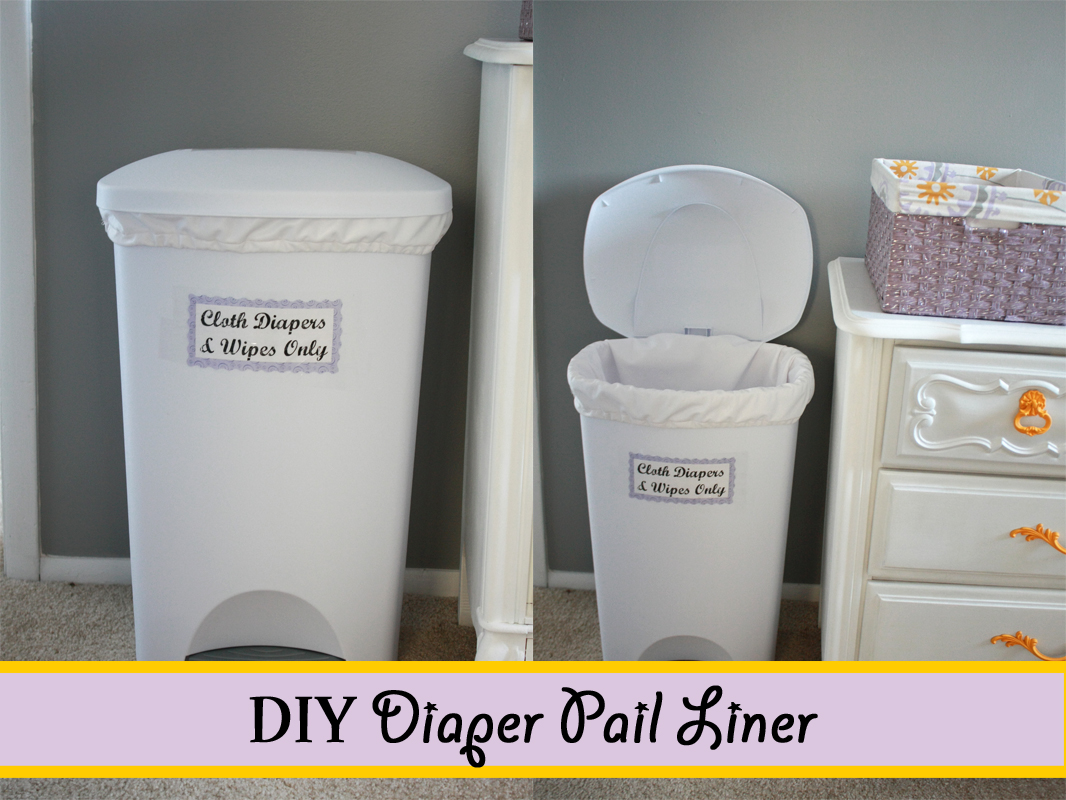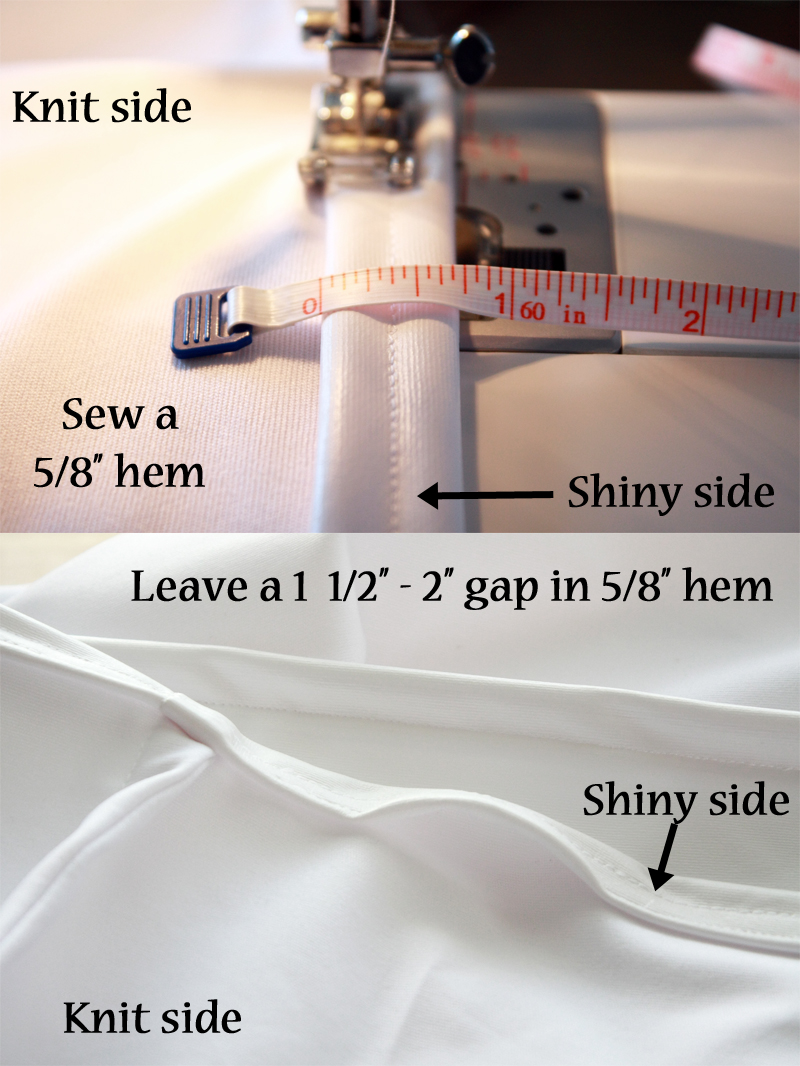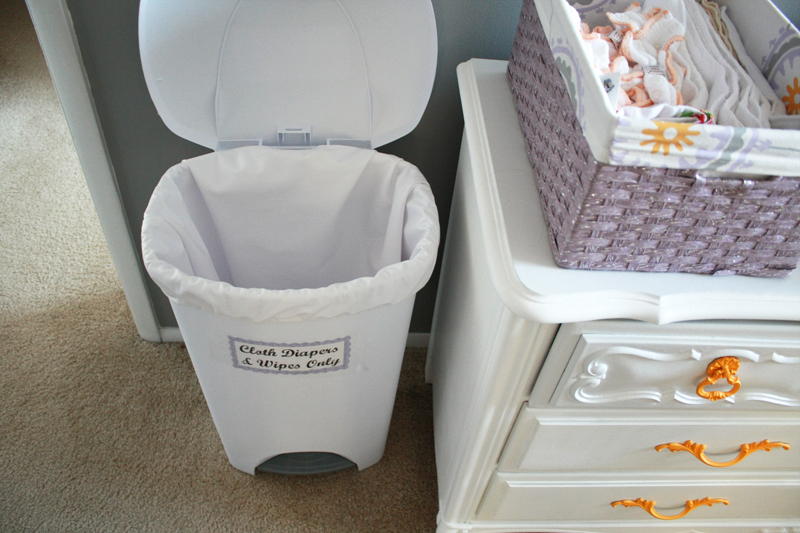
After last week's doozy of a post on how to recover a glider, I figured it was time for something easy. Something that takes, oh maybe 30 minutes?
No ironing. No pinning. Promise.
The only catch? You're going to be working with polyurethane laminate fabric -- more commonly known as PUL. And it's a slippery little bugger.
So, what do I have in store for you this week? How about making your own diaper pail liner. Now, if you're going the route of disposable diapers, just ignore this... pass on by. Use a trash bag and call it a day. However, if you are choosing to cloth diaper, as we are, a PUL pail liner is the perfect item to line your diaper pail. It's waterproof AND washable. All you need to do is drag your full bag of stinky diapers to the washer, dump the diapers in, then turn your bag inside out (so dirty side is facing out) and throw it in the wash.
Things You'll Need
1 yard PUL fabric (or 1 2/3 yards if making 2)
36" elastic, 1/4"-3/8" width
Spool of polyester thread in matching color
Scissors
Tape measure
Pail Liner is designed to fit a 11-13 gallon trash can
Before we begin, let's familiarize ourselves with the fabric. There are two sides to PUL, a shiny waterproof side (that's very slippery), and a dull knit-like side. I purchased mine from Joann's (Babyville Boutique), which I found in a completely different area than the rest of the fabric.
Now, some people have noted that this type of fabric tends to be "sticky" going through their machine, and it can tend to gather a bit if this happens. A few solutions if you find you're running into this: 1) use a walking foot (it has extra feed dogs which help keep the fabric moving), 2) use tissue paper on top between the fabric and foot, or 3) sprinkle fabric with baby powder where you plan to sew.
One more note: since this fabric is waterproof and any punctures to the fabric (from needles) will not disappear, it is crucial that you try and make as few holes in it as possible. This is where not pinning the fabric comes into play. You can use other items like hair clips or bobby pins to keep the fabric together, but try to stay away from anything that goes through the fabric.

Alright, now that we have that business out of the way, we can begin. Lay out your fabric, folded in half lengthwise (as it came off the bolt), with the shiny sides together. Cut your fabric so the fold side is 27 1/2" (this will be the bottom of your bag), and the sides are 29". Your final bag size will have a circumference of about 51 1/2" and a height of 27 1/2".

Refold your piece of fabric so the knit side is facing in and the shiny side is facing out (and it is still a 27 1/2" x 29" rectangle). We're going to use what is known as "French seams" for this project. A French seam basically traps the raw edges inside the seam, and in this case, helps to prevent any wicking. Don't worry, it just sounds fancy.

With your shiny sides facing out, stitch a 1/4" seam along the two open sides of your bag, back tacking at both the beginning and end. (Bottom of bag should be the fold, the two long 29" sides should be sewn together, and the top should be left open.)

Trim the excess fabric on the outside of your seam down to 1/8". I just eyeballed it.

Turn your bag inside out, so the knit side is now on the outside, and the shiny sides are facing each other. Use a chop stick or other dull pointy object to make sure the corners are fully turned out. This is what a typical straight seam looks like. To make it a French seam, we're going to add another 1/2" seam down the length of our sides.
The fabric at the seams is going to try and stay poofy since you can't iron it, so you may need to roll the fabric between your fingers a bit to bring the seam out to the very edge and make the remaining fabric flat.

Below is what your final seam should look like. See how the raw edges are "trapped" inside?

So now we have our general bag shape. All that's left is to add the elastic at the top. One option is to stitch the elastic directly to the bag, but I'm just not a huge fan of the bare elastic look. So we're going to make a nice little casing to thread the elastic through instead.
Measure the top of your trash can or diaper pail to see about how much elastic you're going to need. Mine was 43", so I decided to start with 36".

With your knit side of the bag facing out, fold over the edge of the top of the bag and sew a 1/2" hem. I also just kind of eyeballed and measured the hem width occasionally as I went to make sure I was staying on track.

Fold your hem over 5/8" and stitch close to the outside edge to form a casing for your elastic. Leave a 1 1/2" to 2" gap in your casing.

Thread a pin through your elastic at the 36" mark, and place a safety pin though the elastic at the start (do not pin the elastic to the bag). Thread your elastic through the casing. Once you come back around to your opening, pin the ends of your elastic together.

Place your bag into your diaper pail, folding the elastic down over the top edges of your pail as you would with a typical trash bag. Test the tightness of the elastic. Add or pull out any extra elastic until your bag can easily fit over the top of the can, but will not slide off when you place things in the bag. I ended up using about 29" total of elastic.

Once you find the right length of elastic, sew the ends together. Push the elastic up into the casing and sew your gap shut.

Test to make sure everything fits okay.

The shiny side of the bag should be facing inside. When you open your lid, you should not see any of the seam allowance. You will be able to see the seam allowances on the outside knit side of the bag, which will face the wall of the pail.

And that's that! How's that for an easy-peasy project?

As I mentioned before, this project takes maybe a half hour to complete -- and the only reason it took me that long was because I was being extra careful to make sure everything lined up correctly due to not being able to pin.
If you happened to follow the link earlier to Joann's site for the PUL, you may notice that this isn't exactly the cheapest fabric around. It typically runs about $12.99/yard. Ouch. So plan ahead and make sure you bring along that 40% off coupon.
1 yard PUL fabric @ $7.79/yd = $7.79
1 spool of polyester thread @ $2.99/spool = $2.99
1/8 package 1/4" wide elastic @ $1.98 = $0.25
Final Price = $11.03
If you make 2 (which I recommend so one can be in the wash while you use the other), you only need 1 2/3 yards of PUL, which would bring your final bag total down to $8.24 a bag.
It may not be snazzy (though you can get printed PUL for about $14.99/yd), but it's definitely easy and cheap. Most "brand name" pail liners start around $16.50 and go up from there. Plus shipping. The cheapest Etsy/HyneaCart pail liners I found were about $13.50 without shipping.
Care Instructions
1) Wash your PUL pail liners on a Warm/Cold (or Hot/Cold) cycle, followed by an extra rinse. Use a cloth diaper friendly detergent. Do not use the Sanitize cycle as the water can get too hot. Do not use any softeners, bleach, or other cleaning agents that contain brighteners/additives.
2) You can dry your pail liners on LOW in the dryer or line dry. Do not dry on high, as this will delaminate your liner. Do not use dryer sheets (such as Bounce) if drying in the dryer.
Thank you so much.
ReplyDeleteP.s. babyville suggests drying for 20 minutes on high heat after sewing to seal all holes.
Thanks Courtney! I was just going to post that... :)
DeleteYou're right, they absolutely do. However, it's not recommended to dry them on high every time. Sorry, that's what I was getting at, not the prep.
DeleteI have found with PUL as long as you keep your pins in the seam allowance you are all good. Also, one more sewing trick, Scotch tape. Put it on the bottom of your foot and the fabric will glide through smoothly. I will be trying my hand at a pail liner here pretty quick. Thanks for the tutorial.
ReplyDeleteThank you so much! I am a novice sewer, but this was doable for me. I decided not to use the elastic, but I think it will work just fine.
ReplyDeleteLOVE this and will be making a couple plus a few of your wet bags. Question....Do you have to do the french seam or can you use a serger? Thanks!
ReplyDeleteYou definitely don't have to use the French seams, it's just an extra precaution against wicking. If you're using a serger, just make sure you're using 100% polyester thread and seal the pul in the dryer on high once finished.
DeleteYou definitely don't have to use the French seams, it's just an extra precaution against wicking. If you're using a serger, just make sure you're using 100% polyester thread and seal the pul in the dryer on high once finished.
DeleteThanks! I can't wait to get started.
ReplyDeleteHey there! I made up this tutorial, and I am SO HAPPY with my wet bag! I was on the fence about it, (only because I would have turned my seam at the top in instead of out,) but the other day I needed to wash my diapers in my parents' top loader. I pulled the wet bag out and it was full of water! I just sat there with it hanging, and that water was not going ANYWHERE. Those french seams are the best. Wicking at the bottom of the bag has always been something that bothered me, but I thought I just had to live with. Nope, nope, nope!
ReplyDeleteThanks for this tutorial! One question- did you prewash your PUL fabric before sewing?
ReplyDeleteThanks for this tutorial! One question- did you prewash your PUL fabric before sewing?
ReplyDeleteGreat article. Glad to find your blog. Thanks for sharing.
ReplyDeletenon woven fabric bag making machine